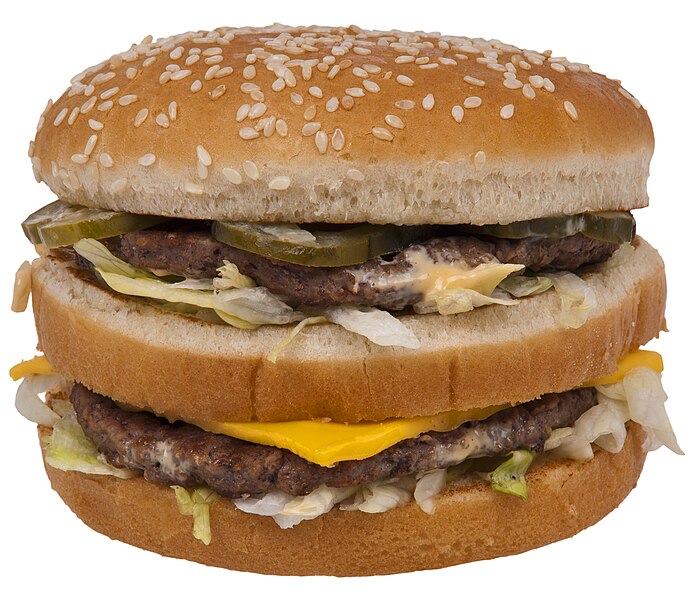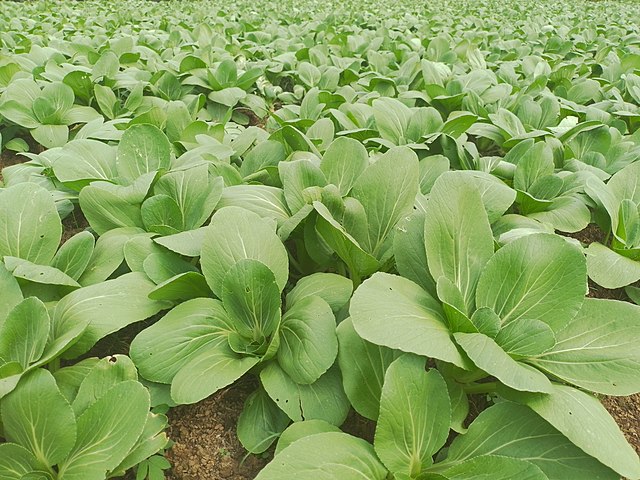Big Mac vs. Bok Choy
Nutrition comparison of Big Mac and Bok Choy
Ever wonder how your favorite foods stack up against each other in terms of nutrition?
We compared the nutritional contents of
big mac
versus
bok choy
(100g each)
below using 2020 USDA and NIH data[1].
For a quick recap of significant nutrients and differences in big mac and bok choy:
- Both bok choy and big mac are high in calcium.
- Big mac has more thiamin, riboflavin, niacin and Vitamin B12, however, bok choy contains more pantothenic acid and Vitamin B6.
- Big mac is a great source of protein.
- Bok choy has 8.2 times less carbohydrates than big mac.
- Bok choy has signficantly less saturated fat than big mac.
- Bok choy is a great source of potassium.
- Bok choy is an excellent source of Vitamin A and Vitamin C.
USDA sources for nutritional information: Big Mac (McDONALD'S, BIG MAC) and Bok Choy (Cabbage, chinese (pak-choi), raw) . Have a correction or suggestions? Shoot us an email.
Calories and Carbs
calories
Big mac is high in calories and bok choy has 95% less calories than big mac - bok choy has 13 calories per 100 grams and big mac has 257 calories.
For macronutrient ratios, big mac is lighter in protein, much lighter in carbs and much heavier in fat compared to bok choy per calorie. Big mac has a macronutrient ratio of 18:31:51 and for bok choy, 36:53:11 for protein, carbohydrates and fat from calories.
Macro Ratios from Calories:
| Big Mac | Bok Choy | |
|---|---|---|
| Protein | 18% | 36% |
| Carbohydrates | 31% | 53% |
| Fat | 51% | 11% |
| Alcohol | ~ | ~ |
carbohydrates
Bok choy has 8.2 times less carbohydrates than big mac - bok choy has 2.2g of total carbs per 100 grams and big mac has 20.1g of carbohydrates.
dietary fiber
Big mac has 60% more dietary fiber than bok choy - bok choy has 1g of dietary fiber per 100 grams and big mac has 1.6g of dietary fiber.
sugar
Bok choy and big mac contain similar amounts of sugar - bok choy has 1.2g of sugar per 100 grams and big mac has 4g of sugar.
Protein
protein
Big mac is a great source of protein and it has 688% more protein than bok choy - bok choy has 1.5g of protein per 100 grams and big mac has 11.8g of protein.
Fat
saturated fat
Bok choy has signficantly less saturated fat than big mac - bok choy has 0.03g of saturated fat per 100 grams and big mac has 3.8g of saturated fat.
cholesterol
Bok choy has less cholesterol than big mac - big mac has 36mg of cholesterol per 100 grams and bok choy does not contain significant amounts.
Vitamins
Vitamin C
Bok choy is an excellent source of Vitamin C and it has 111 times more Vitamin C than big mac - bok choy has 45mg of Vitamin C per 100 grams and big mac has 0.4mg of Vitamin C.
Vitamin A
Bok choy is an excellent source of Vitamin A and it has more Vitamin A than big mac - bok choy has 223ug of Vitamin A per 100 grams and big mac does not contain significant amounts.
Vitamin E
Bok choy and big mac contain similar amounts of Vitamin E - bok choy has 0.09mg of Vitamin E per 100 grams and big mac does not contain significant amounts.
Vitamin K
Bok choy has more Vitamin K than big mac - bok choy has 45.5ug of Vitamin K per 100 grams and big mac does not contain significant amounts.
The B Vitamins
Big mac has more thiamin, riboflavin, niacin and Vitamin B12, however, bok choy contains more pantothenic acid and Vitamin B6. Both big mac and bok choy contain significant amounts of folate.
| Big Mac | Bok Choy | |
|---|---|---|
| Thiamin | 0.176 MG | 0.04 MG |
| Riboflavin | 0.209 MG | 0.07 MG |
| Niacin | 3.384 MG | 0.5 MG |
| Pantothenic acid | ~ | 0.088 MG |
| Vitamin B6 | ~ | 0.194 MG |
| Folate | 46 UG | 66 UG |
| Vitamin B12 | 0.88 UG | ~ |
Minerals
calcium
Both bok choy and big mac are high in calcium. Big mac has a little more calcium (10%) than bok choy by weight - bok choy has 105mg of calcium per 100 grams and big mac has 116mg of calcium.
iron
Big mac has 150% more iron than bok choy - bok choy has 0.8mg of iron per 100 grams and big mac has 2mg of iron.
potassium
Bok choy is a great source of potassium and it has 39% more potassium than big mac - bok choy has 252mg of potassium per 100 grams and big mac has 181mg of potassium.
Customize your serving size
The comparison below is by weight, but sometimes 100g isn't that intuitive of a measurement for food. View a custom portion comparison (e.g. cups, oz, package).
You can try adding or subtracting the amount of either Big Mac or Bok Choy .
Big Mac g
()
|
Daily Values (%) |
Bok Choy g
()
|
|||||
|---|---|---|---|---|---|---|---|
| KCAL % |
|
5% | calories | 5% |
|
KCAL % | |
| G % |
|
5% | carbohydrates | 5% |
|
G % | |
| G % |
|
5% | dietary fiber | 5% |
|
G % | |
| G | 5% | sugar | 5% | G | |||
| G % |
|
5% | total fat | 5% |
|
G % | |
| G % |
|
5% | saturated fat | 5% |
|
G % | |
| G | 5% | monounsaturated fat | 5% | G | |||
| G | 5% | polyunsaturated fat | 5% | G | |||
| G | 5% | trans fat | 5% | G | |||
| MG | 5% | cholesterol | 5% | MG | |||
| MG % |
|
5% | sodium | 5% |
|
MG % | |
| 5% | Vitamins and Minerals | 5% | |||||
| UG % |
|
5% | Vitamin A | 5% |
|
UG % | |
| MG % |
|
5% | Vitamin C | 5% |
|
MG % | |
| IU % |
|
5% | Vitamin D | 5% |
|
IU % | |
| MG % |
|
5% | calcium | 5% |
|
MG % | |
| MG % |
|
5% | iron | 5% |
|
MG % | |
| MG % |
|
5% | magnesium | 5% |
|
MG % | |
| MG % |
|
5% | potassium | 5% |
|
MG % | |
| MG % |
|
5% | thiamin (Vit B1) | 5% |
|
MG % | |
| MG % |
|
5% | riboflavin (Vit B2) | 5% |
|
MG % | |
| MG % |
|
5% | niacin (Vit B3) | 5% |
|
MG % | |
| MG % |
|
5% | Vitamin B6 | 5% |
|
MG % | |
| MG % |
|
5% | pantothenic acid (Vit B5) | 5% |
|
MG % | |
| UG % |
|
5% | folate (Vit B9) | 5% |
|
UG % | |
| UG % |
|
5% | Vitamin B12 | 5% |
|
UG % | |
| MG % |
|
5% | Vitamin E | 5% |
|
MG % | |
| UG % |
|
5% | Vitamin K | 5% |
|
UG % | |
| G % |
|
5% | protein | 5% |
|
G % | |
| UG % |
|
5% | biotin (Vit B7) | 5% |
|
UG % | |
| MG % |
|
5% | choline | 5% |
|
MG % | |
| MG % |
|
5% | chlorine | 5% |
|
MG % | |
| UG % |
|
5% | chromium | 5% |
|
UG % | |
| MG % |
|
5% | copper | 5% |
|
MG % | |
| UG % |
|
5% | fluoride | 5% |
|
UG % | |
| UG % |
|
5% | iodine | 5% |
|
UG % | |
| MG % |
|
5% | manganese | 5% |
|
MG % | |
| UG % |
|
5% | molybdenum | 5% |
|
UG % | |
| MG % |
|
5% | phosphorus | 5% |
|
MG % | |
| UG % |
|
5% | selenium | 5% |
|
UG % | |
| MG % |
|
5% | zinc | 5% |
|
MG % | |
| G | 5% | Water | 5% | G | |||
| G | 5% | Starch | 5% | G | |||
| G | 5% | Alcohol | 5% | G | |||
FAQ
Does bok choy or big mac contain more calories in 100 grams?Big mac is high in calories and bok choy has 100% less calories than big mac - bok choy has 13 calories in 100g and big mac has 257 calories.
Is bok choy or big mac better for protein?
Big mac is a great source of protein and it has 690% more protein than bok choy - bok choy has 1.5g of protein per 100 grams and big mac has 11.8g of protein.
Does bok choy or big mac have more carbohydrates?
By weight, bok choy has 8.2 times fewer carbohydrates than big mac - bok choy has 2.2g of carbs for 100g and big mac has 20.1g of carbohydrates.
Does bok choy or big mac contain more calcium?
Both bok choy and big mac are high in calcium. Big mac has a little more calcium ( 10%) than bok choy by weight - bok choy has 105mg of calcium in 100 grams and big mac has 116mg of calcium.

